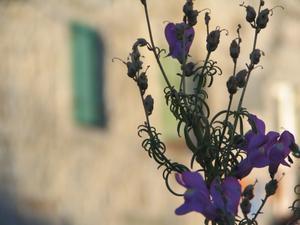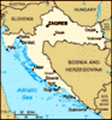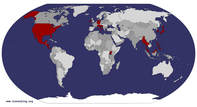Advertisement
Published: September 11th 2005

 True Colors of Croatia
True Colors of Croatia
Even the weeds and plants taking over the cracks in Diocletian´s palace were beautifulI pulled my hood over my head and huddled inside my sweatshirt for warmth as the train rolled through misty Ljubljana. I dozed off to the sight of colourful cathedrals and castle turrets peeking out of the fog-covered hills as the sun fought to break through the clouds. A late night prior to departure ensured that I slept straight through to my destination point of Rijeka, Croatia. But when I opened my eyes a mere two and a half hours later, I was quite disoriented. In just two and a half hours my surroundings had drastically changed, from 18° to 30°, from misty to glaringly sunny, from mountains to sea level, from pine trees to palms, and from reminders of Austria to reminders of Italy. The western coast of Croatia, and in particular the northwest, has had more than its share of Italian influence, as the region actually changed hands many times between the warring European superpowers of the day, and most cities along the coast also have Italian and/or German names as well. I checked out a map and found my way to the bus station to change money, drop my bag, and find the ferry office. A friendly older
retired Croatian man who lives in Australia bought me a coffee and helped me find my way to the local bus for my day venture to Opatija.
As I sat back and watched the scenery roll by, my jaw hung open. My mind was racing with the incapability to put into words or coherent thoughts the physical world around me, without inventing names like amazibeautifabulous. The town itself was a tasteful farrago of Italian and Austro-Hungarian, the ornate architecture harmoniously blending with the stateliness of the sculptures and well-designed public gardens. Giant Baroque villas under the shade of palms and fig trees stood their ground against the grapevines twisting and circling their way up their walls, as they clung firmly to the rocky hillside that threatened to toss them down into the waves lapping softly at their feet. The sea was an amazingly light shade of green at the rocky shoreline, soon fading into glimmering turquoise at waist level and suddenly dropping off into the deepest blue beyond. The red tile roofs and the light-, almost white-, colored stone of the houses themselves stand out along with the rainbow of flowers cascading from balcony flower gardens to accentuate the
otherwise monotonous sea of greens from the cypress trees and pines.
If aesthetic perfection existed, I believe I may have just stumbled upon it. Were I the judge in the European beauty contest, Croatia would quite easily steal the crown.
I took perch on the edge of a “beach” (no sand; they are all rocky beaches so there are some bars with sand dragged in…but the plus side of that is that the water is crystal clear) to admire the view and spend the day shocking my system into adapting to its new climate by sunning and swimming for the entire afternoon. After a short night and a day in the heat, however, I was more than ready for 8 pm to come to climb onto the ferry and go to bed. I paid the extra 5 € to spring for the reclining seat at the last moment, so that I could hopefully get a decent night’s sleep. But there is just something so romantic about setting sail by boat; although it was just a ferry, and even though I had no one to bid farewell to below, I found myself drawn to the deck to wave goodbye

 Feast of the Assumption
Feast of the Assumption
This Catholic celebration continued on August 15th despite the rainand watch Rijeka fade into an unrecognizable spot on the horizon. However, stating that it was “just a ferry” betrays my true affection for this Jadrolinija vessel…not only I was truly enamoured through our brief encounter to the point that I have convinced myself that sea travel is the only way to go, but with its full-service restaurant, children’s playroom, movie theatre, and showers, this ferry was the equivalent of the backpacker’s luxury liner. And as I skirted past the hordes of “deck-only” passengers camped in the aisles, spilling out into the halls and from under cafeteria tables, into my room where hundreds of lush reclining chairs housed only a handful of occupants, I felt as if I had actually splurged for the upper-deck, ocean-view suite in this cruise ship. If only all my travel destinations could be reached via the Jadrolinija Dubrovnik!
Arriving into Split at sunrise, I found a port-side bench where I could leisurely enjoy my breakfast while waiting for the tourist office to open so I could hopefully get some assistance finding accommodation. However, even at that early hour, it didn’t take long for the touts to arrive, and I negated and negotiated my way
into an apartment with the French-German couple on the neighbouring bench. After waking from a nap, my initial dismay at the drizzle that had driven away the early morning sunshine was short-lived, as I was pleasantly surprised at how delightful this city could be if you were able to manage to escape from the swarms of Italians clogging up the tiny alleys around Diocletian’s palace.
Given that my travel guide had described the city as “hideously ugly”, I had come into Split with low expectations. However, whoever wrote that was either born in a jewel-encrusted mansion on a Maldivian atoll or is simply a perpetual fault-finder, for there was plenty of beauty to go around. Granted, I would not recommend a Croatian vacation in July or especially in August, when you are competing for every inch of space your body takes up with half of France, Italy, and Croatia as you finagle your way through the sights of the palace. However, as with many well-touristed locales in the world, there is a reason flocks of tourists put up with each other to be in that place. A Greek flavour made itself present in the whitish stone with which everything
is built in Split, and the narrow hillside residential walkways reminded me of the famous Placa district in Athens. But the Palace itself was quintessential Italian, and the rustic shutters and red tile roofs on the houses in the center conjured up memories of Tuscany. The fortified walls of the palace, originally built between 295 and 305 AD as a retirement home for the former Roman emperor Diocletian, housed a large area complete with mausoleum, temples, administrative buildings, and later a cathedral in the center. The giant outdoor market was also not to be missed, as widowed ladies dressed all in black from scarves to shoes let their stern expressions fade into a smile as you sampled their homemade cheeses and their olive oil sold in Coca-Cola bottles.
To escape the crowds, the forest-covered peninsula that comprises the western part of the city provided an easy fix. A walk to Marjan Hill required a wander through the small footpaths and up the many stairs that kept this residential area free of traffic. Nearly every house had some sort of latticed-top walkway, veranda, or terrace where grapevines built a canopy under which purple, pink, and white flowering bushes flourished and
draped the house in color. Amidst the clank of pots and pans and savoury smells wafting from their kitchen windows, mothers kept a watchful eye on the children who played soccer on the stairs. Marjan Hill itself was a medley of ivy, cypress, pine, and olive trees, criss-crossed by walking paths and dotted with tiny round-topped chapels no bigger than your average bathroom. But the biggest draw was the view: full panoramas of the sun setting on the still-as-glass sea, with clouds glowing pink and casting a similar hue on the water below and on the white mountaintops that provided backdrop to the old city.
The unseasonable rain, however, urged me to make an early departure from the city, as I figured that a muddy archaeological site at Solin would be no more attractive than a daytrip to Trogir in the downpour. And besides, everyone I met from Croatia along the way had one thing to say about my first visit to their country: “You must visit Dubrovnik.” Once again, I found a reasonable deal from a tout upon arrival, and within minutes of settling into my room I decided to throw out my former ideas of island-hopping back

 Vestibule
Vestibule
Diocletian´s Palace (Split)up the coast because the lethargy of this town had already caught me.
Dubrovnik, the so-called “Pearl of the Adriatic”, lives up to its reputation. The old city’s white marble streets and fourteenth/fifteenth/sixteenth-century buildings are enclosed by enormous walls from the same time period, complete with 14 towers and a fortress, and reaching 75 feet into the air at some points. Sitting outside the walls by the old city harbour one night, I could almost imagine myself back in the medieval age; more than anything, Dubrovnik was a city where I really felt TIME. And despite the crowds on the main thoroughfare, climbing the countless stairs up one of the side streets often rewarded me with a view of the old city all for myself. However, by this point, I had basically given up on photographing Croatia, for the magic that she holds simply can not be captured with a lens; my feeble attempts at doing so only frustrated me when I compared reality with the image staring back at me. One must simply see her beauty to believe it.
And so I spent the rest of my days in Dubrovnik unencumbered, simply tasting the experiences she offered
me. My dive instructor from Honduras popped back up on the grid, as he had since taken a new position on a live-aboard ship plying the Mediterranean waters and happened to be docking in Dubrovnik the same day I arrived, so we were able to have a short reunion over dinner before he set sail again. During the day I generally tried to sneak out before the Italian guys across the way would wake me with their incessant loud phone calls which all ended in “Ciao, ci-ciao, ciao ciao ciao, ciao-ciao, ci-ciao, ciao, ciao. Ciao.” (I don’t think it’s possible to end a phone conversation with less than 10 ciaos), and I attempted to catch a little of that glorious Croatian sunshine. While trying to maneuver my way between the rocks to reach the beckoning emerald sea, I met four guys from France who made my morning escapes easier. This hilarious crew let me tag along to paint the town red that night and together we rented a boat to cruise around the island of Mljet, which is mostly a pine-covered forest, with the western third of it a national park. We pulled into a yacht harbour for lunch and

 Cathedral
Cathedral
Diocletian´s Palace (Split)did our best to blend in with the wealthy boaters by ordering generous portions of the best grilled squid I’ve ever eaten. Back on the water, the sea was marvellously clear; we could easily see everything 13 meters down - shame that none of us had masks or snorkels. But swimming and diving from the rocks with no one else around was like discovering our own pristine playground, so we couldn’t really complain.
However, when the time came to leave Croatia, I was definitely ready to move on. Although I met some nice locals along the way, and although there were some interesting historical lessons (for example, I had never heard of the extermination programs under Ante Pavelic’s fascist government in the 1940s, in which over half a million Serbs and Jews were brutally killed), overall the experience was lacking something. To be fair, I was in the most touristed part of the country during the most touristed time of the year, so another trip in another season might have created a completely different impression; but in comparison with Slovenia where my touristy peak season adventures still left me a taste of what lies beneath the surface, Croatia was
overwhelmingly superficial in her charms.
The allure of Croatia seemed to be only as skin-deep as that of the beauty queen: a marvel to behold, but seriously lacking in character. If I were to judge all books by their covers, however, Croatia would still win my vote as the prettiest country in Europe.
Advertisement
Tot: 0.22s; Tpl: 0.017s; cc: 27; qc: 104; dbt: 0.1361s; 1; m:domysql w:travelblog (10.17.0.13); sld: 1;
; mem: 1.5mb
























